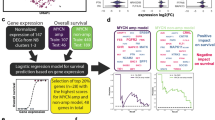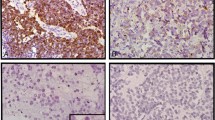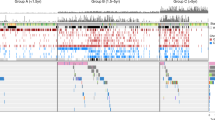Abstract
Expression of the c-kit proto-oncogene product in neuroblastomas has been reported, but its clinical relevance is unclear. We determined the expression of c-kit by immunohistochemistry in a series of 155 neuroblastomas with long-term follow-up. The specificity of the reaction was verified by Western blot analysis and quantitative RT–PCR, and exon 11 of the kit gene was screened for mutations by PCR and capillary electrophoresis. No mutations were detected, and transcription of the kit gene correlated with protein expression. c-kit expression was associated with lower tumor stages and a low rate of MYCN amplification. More importantly, it coincided with tumor differentiation (P<0.0001), and portended a favorable outcome with a relative risk of 0.18 (P<0.0001). In a multivariate analysis of event-free survival, loss of c-kit (relative risk 4.25, P<0.0001) was an independent prognostic factor next to INSS stage 4 and before MYCN amplification. It is concluded that c-kit is transcriptionally regulated in neuroblastomas. Its expression likely identifies a subset of neuroblastomas with conserved capacity for differentiation, which may represent the embryonal variety of the disease. Assessment of c-kit may improve prognostic models for neuroblastoma and provide a basis for new therapy concepts.
This is a preview of subscription content, access via your institution
Access options
Subscribe to this journal
Receive 50 print issues and online access
$259.00 per year
only $5.18 per issue
Buy this article
- Purchase on Springer Link
- Instant access to full article PDF
Prices may be subject to local taxes which are calculated during checkout


Similar content being viewed by others
References
Arber DA, Tamayo R and Weiss LM . (1998). Hum. Pathol., 29, 498–504.
Bar-Eli M . (2001). Pigment Cell Res., 14, 78–85.
Beck D, Gross N, Brognara CB and Perruisseau G . (1995). Blood, 86, 3132–3138.
Berthold F, Sahin K, Hero B, Christiansen H, Gehring M, Harms D, Horz S, Lampert F, Schwab M and Terpe J . (1997). Eur. J. Cancer, 33, 2092–2207.
Brodeur GM, Pritchard J, Berthold F, Carlsen NL, Castel V, Castelberry RP, De Bernardi B, Evans AE, Favrot M, Hedborg F, Kaneko M, Kamshead J, Lampert F, Lee REJ, Look AT, Pearson ADJ, Philip T, Roald B, Sawada T, Seeger RC, Tsuahida Y and Voûte PA . (1993). J. Clin. Oncol., 11, 1466–1477.
Caruana G, Cambareri AC and Ashman LK . (1999). Oncogene, 18, 5573–5581.
Cohen PS, Chan JP, Lipkunskaya M, Biedler JL and Seeger RC . (1994). Blood, 84, 3465–3472.
De Sepulveda P, Okkenhaug K, Rose JL, Hawley RG, Dubreuil P and Rottapel R . (1999). EMBO J., 18, 904–915.
DiPaola RS, Kuczynski WI, Onodera K, Ratajczak MZ, Hijiya N, Moore J and Gewirtz AM . (1997). Cancer Gene Ther., 4, 176–182.
Hayashi S, Kunisada T, Ogawa M and Nishikawa S . (1995). DNA Res., 2, 211–228.
Hirata T, Morii E, Morimoto M, Kasugai T, Tsujimura T, Hirota S, Kanakura Y, Nomura S and Kitamura Y . (1993). Development, 119, 49–56.
Hirota S . (2001). Int. J. Clin. Oncol., 6, 1–5.
Hiyama E, Hiyama K, Yokoyama T, Matsuura Y, Piatyszek MA and Shay JW . (1995). Nat. Med., 1, 249–255.
Hornick JL and Fletcher CD . (2002). Am. J. Clin. Pathol., 117, 188–193.
Huang EJ, Nocka KH, Buck J and Besmer P . (1992). Mol. Biol. Cell, 3, 349–362.
Ida Jr JA, Dubois-Dalcq M and McKinnon RD . (1993). J. Neurosci. Res., 36, 596–606.
Jahn T, Seipel P, Coutinho S, Urschel S, Schwarz K, Miething C, Serve H, Peschel C and Duyster J . (2002). Oncogene, 21, 4508–4520.
Joshi VV, Cantor AB, Altshuler G, Larkin EW, Neill JS, Shuster JJ, Holbrook CT, Hayes FA, Nitschke R, Dunean MH, Shoahat SJ, Talbert J, Smith EI and Castleberry RP . (1992). Cancer, 69, 2197–2211.
Kapur R, Cooper R, Zhang L and Williams DA . (2001). Blood, 97, 1975–1981.
Keller JR, Ortiz M and Ruscetti FW . (1995). Blood, 86, 1757–1764.
Kindblom LG, Remotti HE, Aldenborg F and Meis-Kindblom JM . (1998). Am. J. Pathol., 152, 1259–1269.
Krams M, Claviez A, Heidorn K, Krupp G, Parwaresch R, Harms D and Rudolph P . (2001). Am. J. Pathol., 159, 1925–1932.
Krams M, Hero B, Berthold F, Parwaresch R, Harms D and Rudolph P . (2002). Cancer, 94, 854–861.
Krams M, Hero B, Berthold F, Parwaresch R, Harms D and Rudolph P . (2003). Am. J. Pathol., 162, 1019–1026.
Lammie A, Drobnjak M, Gerald W, Saad A, Cote R and Cordon-Cardo C . (1994). J. Histochem. Cytochem., 42, 1417–1425.
Lev S, Blechman JM, Givol D and Yarden Y . (1994). Crit. Rev. Oncogenom., 5, 141–168.
Maeda H, Yamagata A, Nishikawa S, Yoshinaga K, Kobayashi S and Nishi K . (1992). Development, 116, 369–375.
Makhlouf HR, Remotti HE and Ishak KG . (2002). Am. J. Surg. Pathol., 26, 493–497.
Miyazawa K, Williams DA, Gotoh A, Nishimaki J, Broxmeyer HE and Toyama K . (1995). Blood, 85, 641–669.
Montone KT, van Belle P, Elenitsas R and Elder DE . (1997). Mod. Pathol., 10, 939–944.
Nakagawara A, Arima Nakagawara M, Scavarda NJ, Azar CG, Cantor AB and Brodeur GM . (1993). N. Engl. J. Med., 328, 847–854.
Natali PG, Nicotra MR, Sures I, Santoro E, Bigotti A and Ullrich A . (1992). Cancer Res., 52, 6139–6143.
Robinson LL, Gaskell TL, Saunders PT and Anderson RA . (2001). Mol. Hum. Reprod., 7, 845–852.
Rudolph P, Chiaravalli AM, Pauser U, Oschlies I, Hillemanns M, Gobbo M, Marichal M, Eusebi V, Höfler H, Capella C and Klöppel G . (2002). Virchows Arch., 441, 238–248.
Schwartz S, Heinecke A, Zimmermann M, Creutzig U, Schoch C, Harbott J, Fonatsch C, Loffler H, Buchner T, Ludwig WD and Thiel E . (1999). Leuk. Lymphoma, 34, 85–94.
Shimada H, Ambros IM, Dehner LP, Hata J, Joshi VV, Roald B, Stram DO, Gerbing RB, Lukens JN, Matthay KK and Castleberry RP . (1999). Cancer, 86, 364–372.
Sipos B, Weber D, Ungefroren H, Kalthoff H, Zuhlsdorff A, Luther C, Torok V and Kloppel G . (2002). Int. J. Cancer, 102, 592–600.
Smithey BE, Pappo AS and Hill DA . (2002). Am. J. Surg. Pathol., 26, 486–492.
Timeus F, Crescenzio N, Valle P, Pistamiglio P, Piglione M, Garelli E, Ricotti E, Rocchi P, Strippoli P, Cordero di Montezemolo L, Madon E, Ramenghi U and Basso G . (1997). Exp. Hematol., 25, 1253–1260.
Torihashi S, Nishi K, Tokutomi Y, Nishi T, Ward S and Sanders KM . (1999). Gastroenterology, 117, 140–148.
Tsuura Y, Hiraki H, Watanabe K, Igarashi S, Shimamura K, Fukuda T, Suzuki T and Seito T . (1994). Virchows Arch., 424, 135–141.
Yarden Y, Kuang WJ, Yang-Feng T, Coussens L, Munemitsu S, Dull TJ, Chen E, Schlessinger J, Francke U and Ullrich A . (1987). EMBO J., 6, 3341–3351.
Acknowledgements
This work was supported by grants from the Kinder Krebs Initiative, Buchholz Holm-Seppensen, Germany, and the Else Kröner-Fresenius Stiftung, Bad Homburg, Germany. We thank Professor Holger Kalthoff for the opportunity to perform LightCycler analyses in his laboratory.
Author information
Authors and Affiliations
Corresponding author
Rights and permissions
About this article
Cite this article
Krams, M., Parwaresch, R., Sipos, B. et al. Expression of the c-kit receptor characterizes a subset of neuroblastomas with favorable prognosis. Oncogene 23, 588–595 (2004). https://doi.org/10.1038/sj.onc.1207145
Received:
Revised:
Accepted:
Published:
Issue Date:
DOI: https://doi.org/10.1038/sj.onc.1207145



